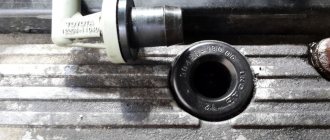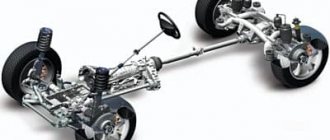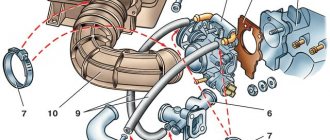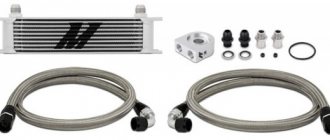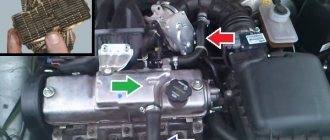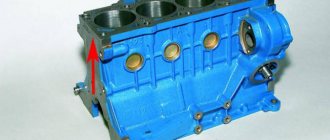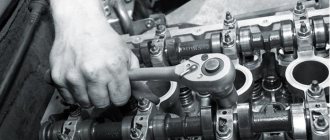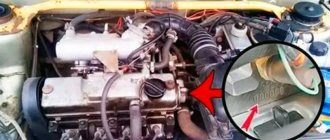Not all motorists, especially beginners, know what an engine breather is for and what it is. This element is often mentioned in vehicle operating recommendations. This element helps diagnose important problems that are directly related to the car’s engine. Why? Yes, because often problems with this element can subsequently lead to problems with the power unit. And as a result, all this will result in expensive repairs. For this reason, every motorist should know everything about such a device and have at least the slightest idea of how malfunctions in its operation can be prevented.
What is an engine breather and why is it needed?
Everyone knows that the internal combustion engine, the same one that is installed under the hood of your car, does not run on gasoline, diesel or gas, but on their mixture with air.
Moreover, it is air, which costs nothing (unlike fuel, for which we regularly pay a tidy sum at the gas station), that is required many times more. But in addition to the influx of clean air and the removal of exhaust gases through the exhaust pipe, parasitic gases are formed during the operation of the internal combustion engine. A breather is nothing more than a breathing valve that constantly relieves excess pressure that forms inside the engine during operation. The need for this simple, relatively inexpensive part is difficult to overestimate.
Purpose
The task of the breather in a car design is to connect the engine sub-piston space with the atmosphere. Additionally, the breather is installed in the valve cover of the block head.
During operation of the power plant, the movement of components, mechanisms, and lubricant leads to an increase in pressure inside the crankcase and under the cover. In addition, crankcase gases accumulate in the sub-piston space, which also increases the pressure.
Piston rings are not able to ensure complete tightness of the combustion chamber, so some of the working gases break through and enter the sub-piston space.
The operation of the motor is accompanied by temperature changes, which causes condensation to form inside. The accumulation of moisture inside the motor is unacceptable, since it is the main cause of corrosion.
A mixture of working gases that have broken into the crankcase, moisture, and oil particles that are mixed in contact with the lubricant are called crankcase gases. An increase in pressure inside the crankcase is usually accompanied by a deterioration in engine performance, since gases create additional resistance to components and mechanisms.
If gases accumulate in large quantities in the sub-piston space, then they break through leaks and “weak” components - oil seals, dipstick, seals, etc.
Therefore, it is important to equalize pressure and gas removal. And this is done by the breather, which is essentially an air valve. Note that this element is used not only on the engine, it is also used in gearboxes and rear axles.
In addition to maintaining pressure in the cylinder block, many car enthusiasts use the breather to diagnose the engine. It helps determine the degree of wear of the cylinder-piston group and the position of the rings.
When engine components wear out or piston rings become coked, a large amount of gases enters the sub-piston space. And thanks to the breather, this is clearly noticeable by the smokiness of the crankcase gases escaping. If the CPG is in good condition, there is practically no smoke in the crankcase gases.
Design features
Previously, the breather was a regular fitting with a hose attached to it and directed downwards. This design ensured the removal of crankcase gases to the atmosphere. To prevent oil from escaping, an oil separator was installed in front of the breather. This element changed the trajectories of gas movement, while the oil, due to inertia, settled on the walls of the oil separator and flowed into the pan.
Crankcase ventilation system of VAZ 2111: 1. Engine crankcase. 2. Breather. 3. Hose from the breather to the valve cover pipe. 4. Oil separator under the valve cover. 5. A thin hose from the valve cover to the fitting with the throttle body nozzle. 6. Fitting with a jet on the throttle valve block. 7. Thick hose from the valve cover to the inlet pipe.
In modern cars, to improve environmental friendliness, a whole system for removing these gases is used. Thanks to it, they are not released into the atmosphere, but are fed into the cylinders, where they burn.
This system includes:
- Breather.
- Oil separators.
- Pipes.
It is noteworthy that the crankcase gas exhaust system uses several oil separators - labyrinth, centrifugal, and mesh.
The breather is located in various places in the lower part of the engine block. It can be either a separate element or act as a housing for the probe.
The breather is a very simple element in design, but the performance of the engine depends on it. If you turn it off, then within a few minutes the increased pressure will squeeze out the oil. If the oil comes out through the dipstick, then you just need to restore the lubricant level and wipe the engine compartment. But if the oil presses through the crankshaft oil seals, then replacing them is impossible.
There are no moving parts in the breather, so there is nothing to break in it. But it still requires maintenance. The oil separator is not able to catch all the oil and oil particles remain in the gases. Some of them settle on the inner walls of the breather along with soot and pollutants. Gradually, the diameter of the tubes decreases, which impairs crankcase ventilation. In winter, frozen water is added to the dirt on the walls.
On some cars, the crankcase ventilation system provides for the supply of gas to the valve covers, where they additionally pass through an oil trap mesh before entering the cylinders. The honeycombs of this mesh are also clogged with dirt, so the throughput is reduced. This “results” in the pushing of the camshaft seals
Device
The breather is essentially a valve that bleeds air from the engine. As the pressure increases, it begins to allow a certain amount of gases to pass through it. The greater the pressure, the more air can pass through it. To prevent atmospheric air from entering inside, the valve is capable of flowing only in one direction. But on some cars this process is reciprocal. In such versions, a filter is installed in the valve to prevent dust from getting inside the motor.
Most often, the breather is located next to the oil filler neck. Much less often you can find options with its location on the side of the cylinder block. From the outlet pipe there is a hose connected to the air filter housing. This arrangement is typical for all cars. It may differ only in small nuances due to the characteristics of the body. Sometimes there are 2 pipes, in which case the second hose is connected to the injector.
Why does crankcase pressure increase?
How long does it take to change the oil in manual and automatic transmissions?
Having noticed oil leaks in the engine compartment and/or a decrease in the oil level in the crankcase, it is necessary to accurately determine that the diesel engine is breathing. This can be done in the following way. It is enough to unscrew the oil filler cap on a warm diesel engine. If you notice bluish smoke coming from the throat, then the problem is obvious.
Cylinder piston group and cylinder head
The main reason that a diesel engine is breathing is the wear of the cylinder-piston group. During the operation of the internal combustion engine, scuffs form on the cylinder walls, the cylinders themselves gradually break and acquire a changed shape of the walls, and the piston rings wear out or break. As a result of heating, the thermal gaps between the piston and the cylinder walls become too large.
In addition to reducing the efficiency of the seal, wear of the rings and their coking are imposed, which deprives the rings of mobility. In such conditions, engine oil enters the combustion chamber abundantly, and the diesel engine emits blue smoke. Also, the gases formed during the combustion of the fuel-air mixture and the engine oil entering the cylinders actively fill the engine crankcase.
If the diesel engine is very worn out, then a major overhaul is necessary, which will mean boring the cylinders, replacing pistons, rings, etc. Accurate diagnosis of CPG problems requires measuring compression to determine the spread of indicators across the cylinders.
In the event that the diesel engine does not breathe much and the malfunction is only at the initial stage (wear of the cylinder walls is within acceptable limits), some auto mechanics resort to the method of decarbonizing the piston rings. This measure is considered temporary, since further long-term operation of the unit after decarbonization of the rings should not be expected. The best solution would be to replace the rings with new ones.
A diesel engine can also vent due to wear of valves, guide bushings, valve seals, etc. Similar to piston malfunctions and ring decarbonization, timing problems can only be effectively eliminated by comprehensive repairs. Replacing valve seals alone does not have a lasting effect.
Engine crankcase ventilation system
Second on the list of main reasons why a diesel engine is breathing is a clogged crankcase ventilation system. The symptoms of a decrease in the throughput of this system resemble wear of the CPG: increased consumption of engine oil, diesel smoking with blue smoke, etc. In some cases, it is possible to normalize engine operation and eliminate excess oil consumption by cleaning the breathers.
Where is the breather installed?
Breathers on a car are installed:
- in the engine itself;
- in the gearbox device;
- in the design of the front and rear axles;
Note that the functions of these devices are almost the same regardless of the installation location. It should be added that the valve also has an additional filter that prevents mechanical particles, dirt and moisture from entering the engine along with the outside air.
To put it differently, the breather allows those components to “breathe” from which the working fluid cannot leak out, as well as water and dirt from entering from the outside. During operation of the internal combustion engine, the engine oil in the crankcase heats up, which causes it to expand. The air in the crankcase also expands and pressure is created. If this pressure is not relieved, then the oil will begin to squeeze out through the seals, seals and gaskets of the engine. This statement is also true in relation to other components of the car (axles, transfer case, gearbox).
After stopping the engine and stopping the operation of other components, as well as when it gets into water (important for SUVs), cooling occurs. When cooling, the pressure in the container drops, a pressure difference arises again and outside air tries to break through through the gaskets, etc. To counteract these phenomena and safely equalize pressure on the engine, gearbox, etc. breathers are installed. It turns out that the valve prevents water and dirt from entering the power units when the pressure drops, and also does not allow the gaskets to be squeezed out and the working fluid (lubricant) to leak out when excess pressure occurs.
Breather in gearbox
The gearbox must convert the torque in the engine and also change the traction force. It often happens that the gearbox starts to work poorly due to the fact that the gearbox breather is clogged. To avoid any damage, you should clean not only the breather in the engine, but also all the others that are installed in different parts of the machine.
In the gearbox, the breather is located on the gearbox housing cover. Sand or dirt getting into the breather will cause the wheel mounted on the secondary shaft to jam. As a result, wear of bearings and synchronizers increases. It is necessary to wash the breather during each technical inspection, or even more often. If the valve is clogged, the pressure in the gearbox will increase, which will lead to oil leakage through the seals.
Bridge breathers
There is oil inside each axle that connects the wheels. The internal cavity must contact the external environment, and it does this through the breather. With the help of this valve, an increase in pressure inside the bridge itself is eliminated.
Oil pressure rises when it heats up during forward gear operation. The breather also performs a protective function. It protects the bridge from water entering it when the car overcomes a water barrier. There is also a special hole in the middle of the bridge through which oil drains.
Particular attention should be paid to the rear axle crankcase breather. It is located on the rear axle boat, on the right side, at the top
As a result of this valve being clogged, oil may leak. To get rid of this problem, you need to clean the breathers from dirt. You also need to check the free movement of the breather cap. It should move in all directions.
After cleaning the breather, you should check it again after a short run of 20 km. If traces of oil are detected again, this will indicate a malfunction of the device that needs to be replaced. The rear axle breather must always be in good condition, because it plays an important role in the operation of the entire vehicle.
Signs and causes of oil leaking through the breather
Despite its simplicity, this system is very important, and it is necessary to monitor its performance. One of the most common ventilation problems is oil leaking through the breather.
This can become a serious problem in the future, since oil particles entering the manifold and cylinders will clog the channels, and during combustion, increase the amount of soot, which will then enter the crankcase, coking the oil channels, and impairing the operation of the lubrication system.
Signs of oil rut.
There are not many of them. In a carburetor engine, these may be leaks of lubricant inside the air filter housing and significant traces of oil on the filter element itself.
As for injection engines, the problem manifests itself in the form of deposits on the throttle body and the internal surfaces of the intake manifold.
In this case, there may be a drop in engine power and an increase in fuel consumption.
Reasons for oil ejection through the breather.
But there are many of them, and many of them do not relate to ventilation.
Lubricant may flow through this system due to:
- Severe wear of the piston rings and the cylinder-piston group as a whole. Because of this, a very large amount of gases break into the crankcase, and the ventilation simply does not have time to remove them all. Therefore, increased pressure is formed inside the engine, which squeezes oil into the breather;
- Oil separator drain channel is clogged. In this case, the separated oil has nowhere to go, and it is mixed into the passing gases;
- Air filter dirty. The engine sucks in a large amount of air, and if there is not enough air due to a clogged element, the motor will suck it in along with oil from the ventilation system;
- Increased amount of oil in the system. If there is more lubricant in the engine than normal, then excess lubricant will enter the ventilation;
- Ventilation system valve jamming;
- Timing belt wear or valve burnout. As a result, crankcase gases enter the above-valve space, then they penetrate into the crankcase, significantly increasing the pressure.
Engine breather
Some novice drivers are stumped by the question “engine breather and what is it,” because recommendations for the operation and care of a vehicle often mention this important element of the engine.
In addition, the breather often helps diagnose important problems associated with the power unit: the fact is that problems with this element can subsequently cause engine problems, which can then lead to expensive repairs.
That is why the car owner simply needs to know all the aspects and characteristics of the device, as well as have an idea of how to properly prevent disruptions in its operation, because the breather valve, which does not seem like a significant detail at first glance, is of great importance for the proper operation of the power unit.
What is its purpose?
To understand what a breather is, it is recommended to find out what it is for, since this is directly related to its operating principle.
The main task of this device is to reduce pressure in the engine crankcase.
While the car is running, a lot of gases accumulate in the crankcase, which over time create high pressure. If they are not released in time, the engine may stop working, since high pressure will support the pistons, and gas will begin to escape through any other hole. To prevent this from happening, this valve is installed.
Another significant function of the device is to reduce the temperature inside the engine and ventilate it.
Based on the operation of this unit, one can draw conclusions about problems in the operation of the motor.
In normal operating condition, a slightly transparent, barely noticeable smoke can be seen from the unit. There are situations where the engine constantly throws out oil through the breather. This is a common cause of not only valve clogging, but also other technical problems.
The breather valve is an important element that allows communication with the external environment of a closed container. It allows you to equalize the pressure inside the internal combustion engine: if it drops sharply, fresh air will enter through the valve, which will eliminate the difference between the external, atmospheric, and internal pressure created in the crankcase cavity.
The principle of operation of the breather in the engine
Today, a breather valve to reduce pressure is very often installed on SUVs. This is due to the fact that the device is suitable for off-road driving. Breathers prevent oil leakage. Heated engine oil expands, causing engine pressure to increase.
The pressure in engines or in other automotive devices must find a way out. This causes oil to leak out through various gaskets and gaps. To prevent oil leakage, breathers are installed.
All breathers in the car should be checked periodically. Due to the constant movement of oil, debris and dirt remain in it. Breathers must be properly removed and cleaned of contaminants. If it is too dirty, then it must be replaced with a new device. Before installing a new valve, be sure to thoroughly clean the installation area of dirt and debris. This is done to prevent debris from getting into the new device.
Installation location
The breather valve in a car is usually located:
- directly in the engine;
- inside the rear and front axle structures;
- at the checkpoint.
Let's sum it up
Taking into account the above information, it becomes clear that even with its apparent simplicity, the breather of a gearbox, engine or axle performs a rather important function. This means that the condition and proper operation of this element must be monitored.
This is especially true for SUVs, trucks and special equipment, where in addition to gearboxes and internal combustion engines, breathers are installed on bridges. Such machines are often operated in harsh conditions, as a result of which the gearbox or axle pressure reduction valve may become dirty or fail more often (especially the rear axle breather).
Finally, we note that if the owner notices oil leaks from the engine, gearbox, axles, and other components and assemblies through gaskets and seals, this may indicate problems with the breather. If the valve is clogged or faulty, pressure increases in the closed cavity, which causes lubricant leakage.
Also, the unit or assembly itself may stop working normally, which subsequently leads to serious damage. For this reason, it is necessary to clean the breathers installed on different units and elements of the car at every service. If the car was driven off-road, it is recommended that after such trips you immediately wash the breathers to remove dirt and sand.
Troubleshooting
The first thing you need to pay attention to is the color of the exhaust, blue or black smoke, a sign of burnt valves or problems with rings. Next, you should check the compression in all cylinders. The value on gasoline internal combustion engines should be within 11-13 MPa. Disconnect the pipes from the valve covers, air intake and breather
Assess the degree of contamination. If the pipes are very dirty or clogged with oil deposits, use gasoline to clean them or a special carburetor cleaner. Check the condition of the oil separator. Unscrew the required bolts to get to this unit. Remove the oil separator and assess its condition. If necessary, clean or rinse followed by drying. Inspect and, if necessary, flush the breather valve. There are situations when the valve gets stuck, resulting in exhaust gases entering the crankcase and creating excess pressure. Remove the part and wash it; in most cases, this will resolve the issue of squeezing oil out of the breather.
Helpful advice! To distinguish stuck rings from a burnt-out valve, it is enough to perform several manipulations. After checking the compression in the cylinders, determine the cylinder with the lowest value. Then inspect the spark plug of this cylinder; if the rings are lodged in this cylinder, the spark plug will be covered with a thick oil layer. If the valve is burnt out, the spark plug will appear normal without any major abnormalities.
Operating principle of the crankcase ventilation system
Oil smells like gasoline reasons
In order to understand why oil is squeezed out of the breather, I propose to briefly consider the principle of operation of the oil system. Not many people know, but for proper operation of the engine, ventilation is necessary, since during its operation gases collect in the crankcase, and now we are not talking about exhaust gases. To ensure the removal of these gases, old cars used a so-called crankcase ventilation system, which after some time became known as a “breather.” With the help of a breather, engineers were able to ventilate the crankcase and thereby relieve the pressure that forms during engine operation. However, the system turned out to be ineffective, since tiny oil particles penetrated the breather along with excess pressure and gases.
The issue of penetration of “oil dust” into the breather was partially resolved by means of a special mesh that traps oil particles and does not let them into the breather. However, despite this, some of the oil vapors still penetrate into the breather, creating certain difficulties for owners. A small amount of oil that has penetrated into the breather is not considered anything terrible, however, if oil flows out of the breather in large quantities, this is a reason to seriously think about the technical condition of the engine.
Why is there smoke coming from the breather?
There can be only one malfunction of the breather: it began to poorly pass accumulated gases, comparing the pressure inside the engine with atmospheric pressure. But the smoke coming from it can say a lot:
- The cylinder oil scraper rings were stuck or worn out. Simple decarbonization using traditional methods or special chemicals will not help here, so you will have to disassemble the engine.
- Likewise, if one/several exhaust valves burn out. A simple compression test will help determine this.
- Oil seals. Just replace them when it's time or they show signs of increased wear.
- The shaft seals, which allowed oil vapors to pass through, were worn out. Change them without hesitation, preferably without shelving them.
- The oil in the engine is old and needs replacing for a long time. No comments: as practice shows, repairing the “heart” of a car is tens of times more expensive than replacing it.
- White smoke on a hot engine - coolant enters the lubrication system. You'll have to look for where exactly the leak is.
- Oil overflow. In an internal combustion engine, it is just as dangerous as underfilling: engine wear/fuel consumption increases significantly, so check its level with a dipstick on a level surface when the engine is well warmed up. Then you will see how well the technicians at the service station (or you yourself) performed its replacement/topping up.
- The oil is of poor quality/not suitable for the car/counterfeit. There is only one way out - replace it. Likewise, if you filled up with fuel at an unknown gas station: just don’t do it again.
- Finally, the breather itself clogged from time to time, not working at 100%. Simple cleaning and preventive maintenance will eliminate this.
An impressive list of different situations. And there is no doubt that if your car’s breather is smoking, you have definitely found your case among them.
Oil is squeezed out through the breather: how to fix the problem
There are situations when oil leaks through the breather on a car. The liquid is squeezed out, and streaks on the unit become noticeable. This sign indicates the need to perform diagnostic procedures on the engine. Let's try to figure out the problem in the garage. If necessary, the technical fluids needed for replacement can be picked up in Tikamis and ordered there if you live in the service area of this company.
When operating a car, crankcase gases accumulate in the crankcase. Without maintaining excess pressure, we use a special ventilation valve. This way we will cover the crankcase from interaction with the atmosphere. This valve is called the breather.
In the installation, gases are mixed with a mist of oil composition, so the particles penetrate into the element in question. As a result, some of the liquid flows out. This means that we can allow minor contamination of the device.
If leaks occur from the breather, the channels immediately become clogged and soot appears. The remaining substance flows into the crankcase, and the system “cokes.” Parts under load are practically not lubricated, the “engine” wears out. By the way, traces of the composition are not always visible from the outside.
Let's find out the causes of this disease. Oil appears due to worn piston rings. Gases flow from the seal into the crankcase, where overpressure is created. If the level is excessive, oil will leak out from the breather. The oil deflector drains may become clogged.
Why is there a breather in a car?
Pressure in the crankcase of any unit can occur for various reasons, and this is normal in most cases. It's all about its permissible size. Exceeding the normalized threshold leads to troubles in the form of complications with seals with gaskets and seals. Here we need to urgently take action.
All this is done by a breather - a valve or a calibrated channel for communicating with the atmosphere. Other cavities of units can also act as atmosphere, for example, in an engine this is the intake manifold. This method of discharge is more environmentally friendly; hydrocarbons do not flow outside.
The presence of a valve allows you to more accurately control the pressure value. Moreover, in both directions, sometimes instead of pressure there is a vacuum, which also has nothing useful.
Why you need to clean the breather
Operating under the conditions described above means that the breather may become clogged. The release of oil through the valve is accompanied by the subsequent accumulation of dust, which clogs the valve passage. As a result, when heating, excess pressure is created or insufficient pressure when cooling, which leads to oil leakage through the oil seals and gaskets of the engine and other units.
To troubleshoot the problem, the breather must be removed for cleaning or replacement. It is recommended to replace the engine or gearbox breather with a new one if it is very dirty. Before installing a new breather, it is necessary to thoroughly clean the installation site. This will avoid its rapid re-contamination.
Breather device
Typically, the internal structure of the breather is very simple. Let's look at it using the example of a breather for a gearbox/axle.
- External breather housing. It is made of metal, so it cannot be damaged while driving.
- Pressure spring. Thanks to it, the mechanism does not need an electrical/mechanical drive, everything is autonomous.
- Rubber gasket. It is this that ensures tightness when excess pressure is not released.
- Lock nut. The simplest method of fixation: although in other models there are a variety of options.
- The breather body itself. The through hole allows the unit to “breathe”, relieving excess pressure.
Although this breather is not used for engines, the principle is the same. An elementary module that you simply cannot do without.
Preventative work
Some motorists are wondering: why clean the breather? This is done in order to avoid problems with the operation of car components; it is necessary to clean the breather in a timely manner. Such actions will allow you to maintain the permissible pressure level, and as a result, stable and trouble-free operation of the car. It is recommended to carry out cleaning at every technical inspection (MOT), and in some cases even more often. The cleaning process itself looks like this:
- removal of pipes and hose. All pipes and hoses coming from the “breathing valve” are removed; in some models you will also need to remove the air filter housing;
- removing the breather cover;
- cleaning work. Now you can begin cleaning the valve cap and tube.
- installation work. Assembly is carried out in reverse order.
This is how cleaning is done. The procedure is quite simple, and you can do it yourself with your own hands, without the need to visit a service center.


